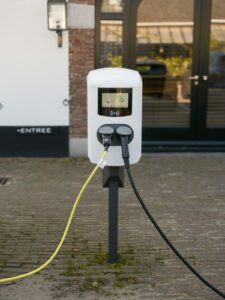
Home / EV Charging News / Wireless Charging: Revolutionizing Electric Vehicle Charging
Wireless charging is an emerging technology that could revolutionize the way we charge electric vehicles. This technology allows for the transfer of electrical energy without the use of cords or plugs. Instead, an electromagnetic field is used to transfer power wirelessly from a charging pad to an electric vehicle’s battery. The convenience of this technology has the potential to eliminate many of the challenges associated with traditional electric vehicle charging methods.
Wireless charging works through a process called electromagnetic induction. This process involves using a magnetic field to create an electrical current. When an electric current flows through a coil of wire, it creates a magnetic field around the coil. This magnetic field can then be used to induce an electrical current in a second coil of wire that is positioned nearby.
A wireless charging pad contains a coil of wire that generates a magnetic field. The pad is typically connected to an electrical outlet and sends electrical energy wirelessly to a receiver coil in the electric vehicle. The receiver coil converts the magnetic energy into electrical energy and sends it to the vehicle’s battery to charge it.
Wireless charging eliminates the need for cords and plugs, making it more convenient to charge electric vehicles. Drivers no longer need to search for charging stations or struggle with tangled cords. Instead, they can simply park their electric vehicle over a charging pad and let it charge wirelessly.
Wireless charging is also safer than traditional charging methods. With no cords or plugs, there is no risk of electrocution from accidental contact. Additionally, wireless charging eliminates the risk of fire caused by overheating or damaged cords.
Wireless charging is also more efficient than traditional charging methods. The electromagnetic field generated by the charging pad can be more precisely directed towards the receiver coil, which minimizes energy loss during the charging process. This results in a more efficient and faster charging experience.
The cost of implementing wireless charging infrastructure can be a significant barrier to widespread adoption. Charging pads and receivers can be more expensive than traditional charging equipment, and retrofitting existing infrastructure can be costly.
There is currently no universal standard for wireless charging technology, which can create compatibility issues between charging pads and electric vehicles. The lack of standardization can also hinder the development of a widespread wireless charging infrastructure.
Wireless charging is limited by its range, which can vary depending on the strength of the magnetic field generated by the charging pad. This can make it challenging to charge electric vehicles over longer distances or in areas with weaker wireless signals.
Several automakers have been exploring wireless charging technology for their electric vehicles. For example, BMW has developed a wireless charging pad called the BMW Wireless Charging system, which is available for the BMW 530e plug-in hybrid. Mercedes-Benz has also announced plans to offer wireless charging for their EQS electric sedan.
Wireless charging infrastructure is also being developed to support the adoption of electric vehicles. Companies such as WiTricity and Qualcomm have developed wireless charging technology for electric vehicles, and wireless charging pads have been installed in public spaces such as parking lots and garages.
Wireless charging may also play a role in the development of autonomous vehicles. Autonomous vehicles are expected to spend a significant amount of time on the road, which will require frequent charging. Wireless charging could offer a more convenient and efficient way to charge these vehicles, allowing them to stay on the road longer.
As wireless charging technology continues to develop, we can expect to see improvements in efficiency, range, and cost. The adoption of universal standards could also make it easier for electric vehicle owners to access wireless charging infrastructure.
Wireless charging could also be integrated with smart grid technology, allowing electric vehicles to charge during off-peak hours when energy demand is low. This would help to reduce strain on the electric grid and make charging more affordable for electric vehicle owners.
Wireless charging is just one example of the many technological advancements driving the electrification of transportation. As more electric vehicles hit the road, we can expect to see continued investment in charging infrastructure and improvements in charging technology.
Wireless charging technology has the potential to revolutionize the way we charge electric vehicles. While there are still some challenges to overcome, the convenience, safety, and efficiency of wireless charging make it an attractive option for electric vehicle owners. As the technology continues to develop and become more widespread, we can expect to see more electric vehicles on the road and continued investment in charging infrastructure.
$2,890.00 Original price was: $2,890.00.$2,790.00Current price is: $2,790.00.
$3,950.00 Original price was: $3,950.00.$3,450.00Current price is: $3,450.00.
$1,650.00 Original price was: $1,650.00.$1,590.00Current price is: $1,590.00.
$2,290.00 Original price was: $2,290.00.$2,150.00Current price is: $2,150.00.
$1,290.00 Original price was: $1,290.00.$799.00Current price is: $799.00.

Your Power Management Partner for Over 25 Years Future Generations Depend on Our Decisions Today ™
2024 © All rights reserved by CyberSwitching